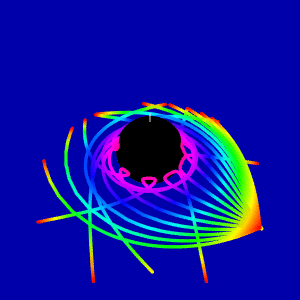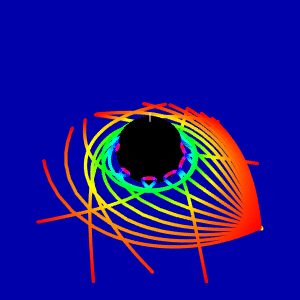Light scattering on the rotating black hole in the Kerr geometry
Physics Asked by Alex Trounev on June 30, 2021
To simulate light scattering on the rotating black hole we have used this paper and this code. First, we made animation for light beam scattering in the equatorial plane
For not equatorial plane the animation looks like
This animation shows difference of light orbits in the direction of rotation and in the counterrotating direction
Gravitational redshift is determined by the equation
$$1+z=frac {lambda _0}{lambda _1}=frac {Sigma}{rho sqrt {Delta}} (1)$$
where $Sigma , rho , Delta $ – parameters of the Kerr metric are expressed in terms of radial and angular coordinates,
$$rho ^2=r^2+ a^2 cos ^2theta, Sigma ^2=(r^2+a^2)^2-a^2 Delta sin ^2theta , Delta = r^2+a^2- 2 M r$$
This question comes from consideration of gravitational red shift picture on the Wikipedia page, which is widely used. My animation is the analog of this picture in the Kerr metric. Is it correct to show redshift from red to blue when light coming to the border of ergosphere computed with equation (1)?
Second question comes from the answer on Do light experience Doppler shift along and against frame dragging? and answer on Gravitational lensing redshift around a Kerr black hole. How we can compute frame dragging effect on the light in the Kerr metric?
Update 1. Taken into account answer @Void the last picture has been recalculated. The new animation looks very different from above.
One Answer
Redshift of photons is an observer-dependent notion. That is, if we want to know how photons get redshifted from point to point, we need to ask who is measuring their frequency. If we do not specify the observers, the question has no meaning.
When one speaks of gravitational redshift, one typically implicitly refers to a class of observers that play a special role with respect to the space-time. For a wave-vector $k^mu$ at a given point, the observer with four-velocity $u^mu$ will see the photon to have a frequency $omega = -u^mu k_mu$. If you have a field of observers with velocities $u^mu(x^nu)$, you can formally assign a frequency to every value of the affine parameter along the lightray as $omega(lambda) = -u^mu(x^nu(lambda)) k_mu(lambda)$. This is how I interpret the pictures in your post.
In Schwarzschild space-time, one would usually choose the static observers with four-velocity $$u^mu = frac{1}{sqrt{-g_{tt}}} delta^mu_t$$ In Kerr space-time, things are a little bit more complicated. Generally, it is natural to choose observers that have a non-zero $u^t$ and $u^varphi$. The redshift formula is then also dependent on the impact parameter of the photon $-k_varphi/k_t$. (Note that $k_varphi,k_t$ are conserved along null geodesics.) The only way to avoid this is to choose the static observers with the same formula for four-velocity as given above. These will not exist within the ergosphere. However, outside the ergosphere you can show that you will have the redshift (blueshift) with respect to infinity given as $$frac{omega}{omega_infty} = frac{1}{sqrt{-g_{tt}}} = sqrt{frac{r^2 + a^2 cos^2 vartheta}{1 - 2 Mr}}$$ This does not match your formula (1). Instead, your formula (1) corresponds to $sqrt{-g^{tt}}$, which is incorrect (it could be completed by an impact parameter term to correspond to the so-called zero-angular momentum observers), even though the qualitative behaviour is OK.
As for your question about frame-dragging. Frame-dragging is hard to quantify locally, it refers once again to observer-dependent comparison between points. You observe frame-dragging in your plots when the photons make "tiny loops" at the edges of the ergosphere. These correspond to the fact that the photons are forced to corotate with the black hole when sufficiently close even though they counter-rotated up to that point.
Come to think of it, there may be an issue in your code. You should see this phenomenon to some degree, but some photons should definitely end up in the black hole.
There is no unique way to locally characterize frame-dragging. I would recommend to instead use global outcomes such as the outgoing angles of the photons as its measure.
Correct answer by Void on June 30, 2021
Add your own answers!
Ask a Question
Get help from others!
Recent Answers
- haakon.io on Why fry rice before boiling?
- Lex on Does Google Analytics track 404 page responses as valid page views?
- Joshua Engel on Why fry rice before boiling?
- Peter Machado on Why fry rice before boiling?
- Jon Church on Why fry rice before boiling?
Recent Questions
- How can I transform graph image into a tikzpicture LaTeX code?
- How Do I Get The Ifruit App Off Of Gta 5 / Grand Theft Auto 5
- Iv’e designed a space elevator using a series of lasers. do you know anybody i could submit the designs too that could manufacture the concept and put it to use
- Need help finding a book. Female OP protagonist, magic
- Why is the WWF pending games (“Your turn”) area replaced w/ a column of “Bonus & Reward”gift boxes?



